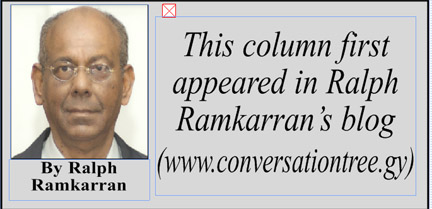The above headline to this article was borrowed from yesterday’s Guyana Chronicle, which reported on an assessment conducted by the United States Agency for International Development (USAID). While observers of the Guyana political scene did not need a foreign agency to confirm what some have been saying for some time, the fact that the USAID has made the same observation, and proposes solutions, lends credibility to the conclusions that 
Guyana’s post-Independence history is one of political domination by the PNC or the PPP. Prior to Independence, and after forms of self-government were conceded by the British, the PPP dominated the political space.
Both political intrigue and violence were deployed to wrest political control from the PPP. By defining the form of governance that has emerged in Guyana as one-party rule, USAID has given credibility to the political analysis that has emerged and, therefore, the need for reform.
Time is not on Guyana’s side. As the report advises: “Guyana’s past demonstrates that that these windows do not remain open for long as engrained practices take over and the government assumes the attributes of the past.” Many observers have been publicly reflecting this view.
From the Guyana Chronicle justifying censorship in an editorial, greeted with silence by the government, to the adoption of irregular methods to acquire the storage bond for pharmaceuticals, about to be baptized as regular, to the resignation of Dr Veerasammy Ramayya as REO of Region 6 and the harrowing reasons of corruption that he gave, it is clear that the weak systems that led to bad governance methods are deeply entrenched. With the best will in the world, these are not going to be transformed unless deep-going reforms are undertaken. With oil income on the horizon, horrors await Guyana if the report is not urgently heeded.
The USAID report pointed out some of the obstacles to reform that Guyanese are very familiar with and regularly bemoan. It said that “governance in Guyana has been characterized by long periods of one-party rule, ethnically divisive politics, inefficient government and corruption.”
It noted that “long-standing acrimony between the PPP/C and PNCR makes achieving consensus on policies, committee appointments and constitutional reform priorities difficult at the national level.”
However, the report found that a shared belief that democracy is the only legitimate form of governance and a shared desire for change facilitate consensus building at the regional and local level. This is doubtful. It is the dog that wags the tail. Regional and local governance take their cue, if not their detailed instructions, from the centre. All these are familiar enough and have been long concluded in several past reports and well-known by all Guyanese.
The report suggests that in order to seize the opportunity offered by the window that is still open, it needs to offer its assistance to the constitutional reform process. Perhaps anticipating the report, this was one theme of the farewell address of Mr Bryan Hunt, US Chargé, in his farewell speech some weeks ago.
But there is no evidence that the government is any longer enthusiastic about constitutional reform, or its purpose, namely, to facilitate a system of governance that would require a real form of inclusivity. The PPP, dreaming dreams of a return to political domination, which might well happen, is unlikely to have any interest in constitutional reform.
The USAID report identifies some of the challenges, which include governance, human rights, political accountability, government responsiveness and effectiveness. It urges USAID to provide assistance to support the constitutional reform process, to bring balance to Guyana’s governance process and to strengthen local government.
In relation to the latter, the bona fides of the main political parties can be tested by proposing a substantial innovation to establish inclusive governance at the regional level. Regional executives can be established with three or five members with assigned responsibilities. The party which holds the majority of members will have a majority of one and the body will be chaired by the Chair of the Region. No party will lose and all will gain. The party that holds the majority in the Region will hold the majority in the executive. The party in the minority will have a substantial say in the governance of the Region. This is the system that needs to be promoted. Who knows? If agreed to and successfully implemented, it may form a template for the national level.




